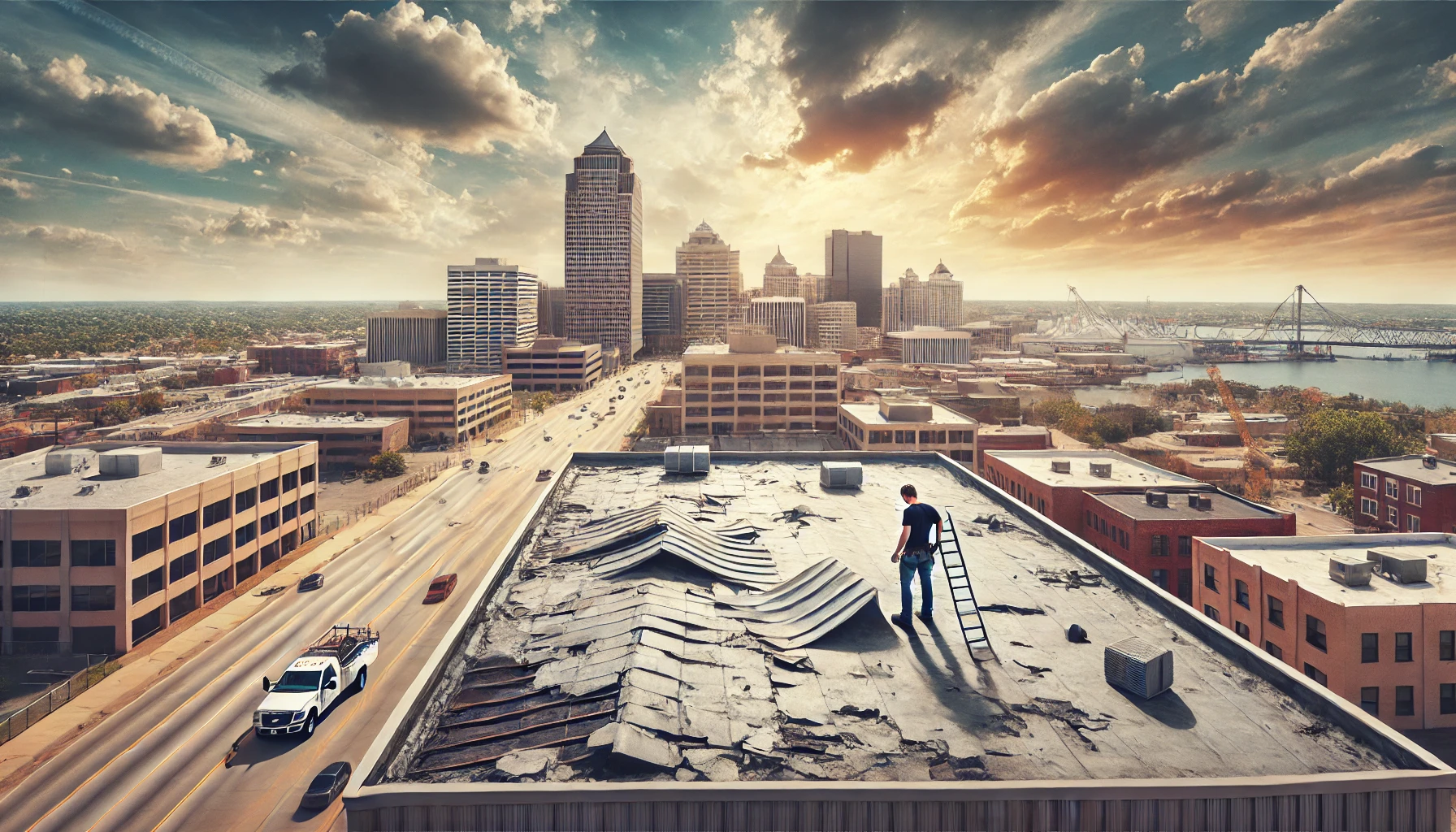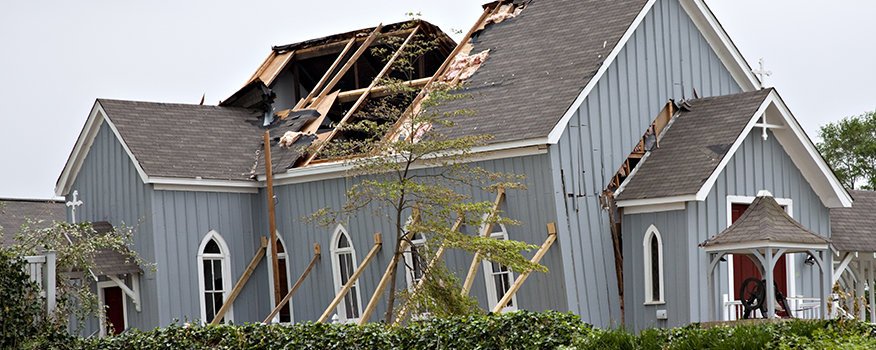Introduction
A well-maintained commercial roof is essential for protecting your building, its contents, and its occupants. In Wichita, where weather conditions can be unpredictable, ensuring the integrity of your commercial roof is even more critical. This article will guide you through identifying signs of roof damage and the steps you should take to address them.
Key Takeaways
- Regular Inspections are Crucial: Conducting regular visual inspections and scheduling professional inspections can help identify roof damage early and prevent major issues.
- Common Causes of Roof Damage: Weather-related factors, wear and tear, poor installation or maintenance, and foot traffic can all contribute to roof deterioration, especially in a climate like Wichita’s.
- Recognize Damage Indicators: Look for exterior signs such as cracked or missing materials and interior signs like water stains and mold. Understanding specific damage indicators can prompt timely action.
- Immediate Steps to Take: Implement temporary repairs to prevent further damage and protect interior assets until professional help can be obtained.
- Choose the Right Roofing Contractor: Ensure the contractor is licensed, experienced, and familiar with local conditions. Ask about their experience with your roof type, warranty options, and repair timelines.
- Understand the Repair Process: Knowing the steps involved in roof repair—from initial inspection and assessment to the actual repair and final inspection—can help manage expectations.
- Preventive Measures: Regular maintenance plans, seasonal inspections, quality materials, and roof coatings can extend the life of your roof and minimize future damage.
- Hypothetical Example: A hypothetical scenario illustrates the process of identifying damage, consulting a professional, deciding between repair and replacement, and taking preventive measures post-repair.
- Professional Services: Contact Solid Rock Commercial Roofing for professional inspection and repair services to ensure the longevity and integrity of your commercial roof.
Understanding the Basics of Commercial Roofing
Commercial roofs come in various types and materials, each with specific strengths and vulnerabilities. The most common types include flat roofs, metal roofs, TPO (Thermoplastic Polyolefin), EPDM (Ethylene Propylene Diene Monomer), and modified bitumen.
- Flat Roofs: Cost-effective and easy to install, flat roofs are common in commercial settings. However, they can be prone to water pooling and leaks if not properly maintained.
- Metal Roofs: Known for their durability and longevity, metal roofs can withstand severe weather but may suffer from rust and corrosion over time.
- TPO Roofing: A single-ply reflective roofing membrane known for its energy efficiency and resistance to ultraviolet, ozone, and chemical exposure.
- EPDM Roofing: Made from a synthetic rubber compound, EPDM roofs are flexible and weather-resistant, but they can be vulnerable to punctures.
- Modified Bitumen: This material combines asphalt with modifiers and solvents, providing excellent durability and resistance to extreme weather conditions.
Common Causes of Roof Damage in Wichita
Several factors can contribute to the deterioration of a commercial roof, especially in a city like Wichita.
- Weather-Related Causes: Hail, wind, heavy rain, and snow can cause significant damage. Wichita’s weather can be particularly harsh, with severe storms and temperature fluctuations.
- Wear and Tear: Over time, all roofing materials degrade. UV exposure, temperature changes, and physical stress can cause materials to weaken.
- Poor Installation or Maintenance: Substandard workmanship and neglect can lead to premature roof failure. Improper installation techniques and lack of regular maintenance exacerbate existing issues.
- Foot Traffic and Equipment: Maintenance personnel, HVAC units, and other rooftop equipment can cause wear and tear, leading to damage.
Identifying Signs of Roof Damage
Regular inspections are crucial for spotting signs of roof damage before they become major issues.
Visual Inspection Guidelines
Conducting a basic visual inspection can help identify obvious problems.
- Exterior Signs: Look for cracked, blistering, or missing materials. Water pooling on flat roofs is a clear indication of drainage issues. Visible leaks during or after rain can also point to damage.
- Interior Signs: Water stains on ceilings and walls, mold growth, and musty odors indicate water intrusion and possible roof damage.
Professional Inspection
While regular visual inspections are beneficial, a professional roofing inspection is essential for a thorough assessment. Professionals can spot less obvious issues and provide a detailed evaluation of your roof’s condition.
Detailed Look at Specific Damage Indicators
Understanding specific damage indicators can help you take timely action.
- Water Leaks and Stains: Water stains on ceilings and walls are a clear sign of leaks. The severity can vary, but any sign of water intrusion should be addressed immediately to prevent further damage.
- Roof Membrane Issues: Look for signs of wear, tear, and punctures in the roofing membrane. Blisters, cracks, and punctures can compromise the roof’s integrity.
- Flashing Damage: Flashing around vents, skylights, and chimneys is prone to damage. Look for loose, cracked, or missing flashing components.
- Ponding Water: Water that remains on the roof for more than 48 hours can cause damage. Identifying and addressing drainage issues can prevent further complications.
- Structural Issues: Sagging areas, rot in the roof deck, and compromised support structures need immediate attention to prevent catastrophic failure.
What to Do Next – Steps to Take
Taking prompt action when you identify roof damage can save time and money.
Immediate Actions to Prevent Further Damage
- Temporary Repairs: Implement quick fixes, such as patching leaks or covering damaged areas with tarps, to prevent further water intrusion.
- Protecting Interior Assets: Move valuable equipment and inventory away from affected areas to minimize damage.
Contacting a Professional Roofing Company
Choosing the right roofing contractor is crucial for effective repairs.
- Qualities to Look For: Ensure the contractor is licensed, experienced, and has positive reviews. Local expertise is also beneficial as it ensures familiarity with Wichita’s weather conditions and building codes.
- Questions to Ask: Inquire about their experience with your specific roof type, warranty options, and the estimated timeline for repairs.
The Repair Process
Understanding the repair process can help you manage expectations and ensure a smooth experience.
Initial Consultation and Inspection
A professional roofer will conduct a thorough inspection to assess the damage and determine the necessary repairs.
Assessment and Quote
The roofer will provide a detailed assessment of the damage and a quote for the repair or replacement. This includes identifying the extent of damage, the materials needed, and the labor involved.
Repair vs. Replacement
Depending on the damage, the roofer may recommend either repair or replacement.
- Cost Considerations: Weigh the costs of repairs against the benefits of a full replacement. Sometimes, repeated repairs can be more costly in the long run than a complete replacement.
- Long-Term Benefits: A new roof can offer better protection, energy efficiency, and longer warranties.
Detailed Repair Process
The repair process typically involves several steps:
- Preparation: Removing damaged materials and cleaning the area.
- Repair: Fixing leaks, replacing damaged sections, and addressing structural issues.
- Final Inspection: Ensuring all repairs meet quality standards and addressing any remaining concerns.
Preventive Measures for Future Protection
Implementing preventive measures can extend the life of your commercial roof and minimize future damage.
Regular Maintenance Plans
Scheduled maintenance can identify potential issues early and keep your roof in optimal condition.
Seasonal Inspections
Adjust inspection frequency based on seasonal changes. For example, inspect the roof before and after winter to address damage from snow and ice.
Proper Installation and Quality Materials
Investing in quality materials and ensuring proper installation can prevent many common roofing issues.
Roof Coatings
Applying roof coatings can extend the life of your roof by providing additional protection against the elements.
Hypothetical Example – A Wichita Business Owner’s Experience
Consider a hypothetical business owner in Wichita who notices water stains on their ceiling.
Scenario Setup
The business owner conducts a basic visual inspection and decides to call a professional roofer.
Step-by-Step Resolution
- Inspection: The roofer finds damage due to hail and poor maintenance.
- Professional Assessment: The roofer provides a detailed assessment and discusses repair options.
- Decision Process: The business owner decides to go with a repair rather than a full replacement.
- Repair Execution: The repair process involves fixing leaks, replacing damaged sections, and ensuring proper drainage.
- Follow-Up: The roofer conducts a post-repair inspection and recommends a maintenance plan to prevent future issues.
Conclusion
Identifying and addressing roof damage early can save significant time and money. Regular inspections, timely repairs, and preventive measures are essential for maintaining the integrity of your commercial roof. If you notice any signs of damage, contact Solid Rock Commercial Roofing for professional inspection and repair services.
FAQs
How often should I inspect my commercial roof?
It’s recommended to perform a basic visual inspection at least twice a year, ideally in the spring and fall. Additionally, professional inspections should be conducted annually, and after any major weather events, to ensure any hidden damage is identified and addressed promptly.
What are the most common signs of roof damage?
Common signs of roof damage include:
Interior: Water stains on ceilings and walls, mold growth, and musty odors.
Exterior: Cracked, blistering, or missing materials, water pooling, and visible leaks.
Can I perform roof repairs myself?
While minor temporary repairs can be done to prevent further damage, it’s crucial to hire a professional roofing contractor for comprehensive inspections and repairs to ensure the work is done correctly and safely.
What should I look for when choosing a roofing contractor?
When selecting a roofing contractor, look for the following:
Clear communication and detailed estimates
Proper licensing and insurance
Positive reviews and references
Experience with your specific roof type
Knowledge of local building codes and weather conditions
How do I know if I need a roof repair or a full replacement?
A professional roofer can assess the extent of the damage and recommend whether a repair or replacement is more cost-effective. Factors influencing this decision include the severity of the damage, the age of the roof, and the long-term benefits of a new roof versus repeated repairs.
What are the immediate steps I should take if I notice roof damage?
If you notice roof damage, take the following immediate steps:
Move valuable equipment and inventory away from affected areas to minimize damage.
Implement temporary repairs, such as patching leaks or covering damaged areas with tarps, to prevent further water intrusion.
How can I extend the life of my commercial roof?
To extend the life of your commercial roof:
Address minor issues promptly to prevent major damage
Schedule regular maintenance and inspections
Use high-quality materials and ensure proper installation
Apply roof coatings for added protection
What are roof coatings, and how do they help?
Roof coatings are protective layers applied to the roof surface to extend its life. They provide additional protection against UV rays, weather, and physical damage, helping to reduce energy costs and prevent leaks.
How does Wichita’s weather affect my commercial roof?
Wichita’s weather, characterized by severe storms, hail, high winds, and temperature fluctuations, can cause significant wear and tear on your roof. Regular inspections and timely repairs are essential to combat these weather-related challenges.
Why should I choose Solid Rock Commercial Roofing for my roofing needs?
Solid Rock Commercial Roofing offers licensed, experienced professionals with local expertise. We provide thorough inspections, high-quality repairs, and preventive maintenance plans tailored to Wichita’s unique weather conditions, ensuring the longevity and integrity of your commercial roof.
This article is a collaboration between Solid Rock Corporation and OpenAI’s ChatGPT. Created on August 6, 2024, it combines AI-generated draft material with Solid Rock’s expert revision and oversight, ensuring accuracy and relevance while addressing any AI limitations.




